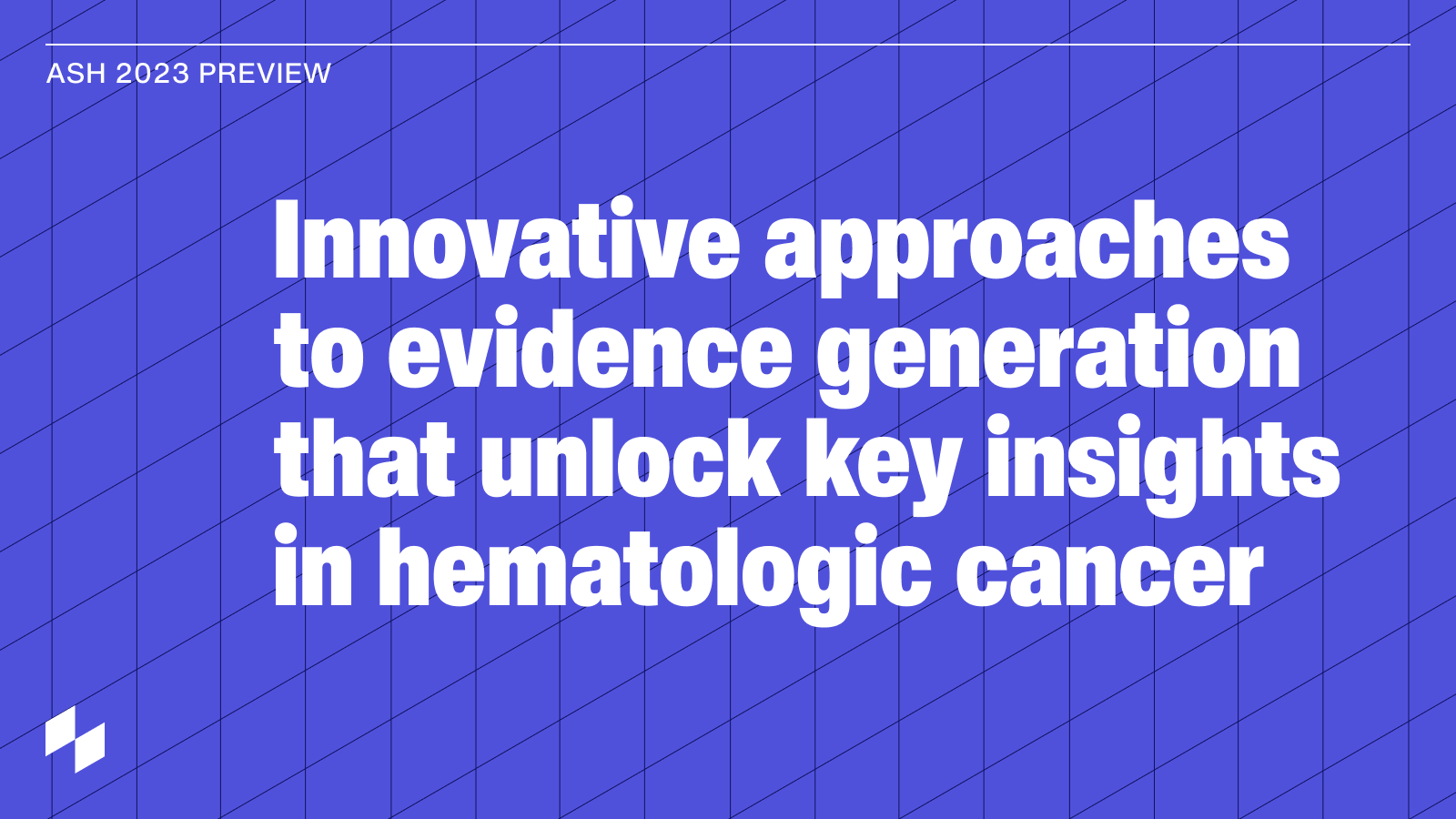This talk is part of the ResearchX session: Beyond synthetic controls: Near-term opportunities for regulatory RWE.
Sections include:
- Near-term opportunities to leverage RWE for regulatory use
- Using RWD to provide natural history information
- Using RWD to fill evidence gaps in the post-approval space: New dosing regimen for cetuximab

Transcript
Kristin Sheffield: Good afternoon. My name is Kristin Sheffield, and I'm a Research Advisor within our Global Patient Outcomes and Real-World Evidence Organization at Eli Lilly, and today, it's my privilege to present an example illustrating how real-world data may be used to fill evidence gaps in the post-approval space. And I would like to recognize and acknowledge the team of colleagues at Lilly who led this effort. Before I begin, I just want to make clear that the views and opinions expressed in his presentation are my own. Next slide, please. So Erbitux received initial approval from the FDA in 2004 for the use in the treatment of metastatic colorectal cancer with a 250 milligram per meter squared weekly dose. Biweekly dosing cetuximab at 500 milligrams has been shown to closely mirror the exposure of the 250 milligram weekly schedule, based on pharmacokinetic exposure data from a phase one dose escalation study. The biweekly dosing schedule is recommended by current international guidelines, such as the NCCN, and it's commonly used in clinical practice.
So there are several potential benefits of a biweekly dosing schedule. In clinical practice, biweekly administration could reduce the burden for patients and medical staff by allowing infusions to be scheduled with other biweekly chemotherapy regimens, potentially reducing the number of patient visits, and the biweekly dosing schedule may lead to a reduction in drug wastage and costs as well. Next slide, please. So I'll briefly provide some background information about the Model-Informed Drug Development Program, because this is the mechanism used by the team to pursue the label change. MIDD is a pilot program that allows drug developers to discuss with FDA the application of exposure-based biological and statistical models derived from preclinical and clinical data to the development and regulatory evaluation of medical products.
And MIDD approaches can optimize drug dosing in the absence of dedicated trials. So the team applied and was accepted in the pilot program and granted two meetings with the FDA. And at the bottom of the slide are some additional examples of how the MIDD pilot program has been used to change dosing regimens and reduce the infusion time for other drugs. Next slide. So the primary evidence in the submission was the population pharmacokinetic modeling and simulation analysis that compared predicted exposures of cetuximab 500 milligrams biweekly to observed cetuximab exposures in patients who received 250 milligrams weekly dose. However, these analyses lacked the treatment exposure response data from cetuximab trials. So to supplement these results, additional supportive evidence was included in the submission, and that included a systematic literature review and meta analysis, which was conducted for clinical studies of patients who received weekly or biweekly cetuximab.
Lilly also submitted an observational cohort study comparing overall survival between weekly and biweekly dosing schedules in patients with metastatic colorectal cancer treated with cetuximab. That's what I'll discuss today. Next slide. Thank you.
The study included patients with stage four or recurrent metastatic colorectal cancer diagnosed on or after January 2013. Patients received first-line, second-line, or third-line treatment with cetuximab plus or minus FOLFIRI, FOLFOX, or irinotecan. Patients had documentation of KRAS wild type status and must have initiated treatment at least six months prior to the end of the database at the time of study conduct.
Patients were assigned to weekly or biweekly cohorts in a line of therapy if they had 70% or more cetuximab infusions with a gap of four to 10 days, or 11 to 18 days respectively from the previous infusion in that line.
One-to-one propensity score matching was used to balance the two cohorts according to baseline clinical and demographic variables. Propensity scores were generated for the line-agnostic overall population, as well as separately for each line of therapy.
Patients were followed from the initiation date of the cetuximab-containing regimen until the end of activity, death, or the end of the database. The primary endpoint was overall survival, and the secondary endpoint was time to treatment discontinuation. In the interest of time today, I'll focus on the mortality results. Next slide. This table shows that there were 1,075 patients in the overall study sample. Approximately 60% of patients received the weekly dosing schedule with a median dose that was close to 250 milligrams per meter squared. Around 40% of patients received a biweekly dosing schedule with a median dose around 485 milligrams per meter squared. These estimates were similar across the first, second, and third lines of therapy. Next slide. After the propensity score matching, the weekly and biweekly cohorts were well-balanced, and Kaplan-Meier overall survival curves are presented here comparing the dosing schedules for the overall population as well as by line of therapy. The blue line represents the biweekly dosing, and the red line is the weekly dosing.
Hazard ratios were generated using Cox proportional hazards regression models, and they represent biweekly compared to weekly dosing. So no significant differences were observed in overall survival in the overall population or by line of therapy. Next slide.
A number of sensitivity analyses were conducted in anticipation of questions from the FDA during the initial meeting, as well as to address FDA comments that were made during that meeting. This table shows just a selection of the sensitivity analyses for the overall population that were conducted.
For example, more stringent rules were applied for classifying patients into dosing cohorts, so requiring that 100% of infusions fell within the respective time intervals for weekly or biweekly dosing.
Another sensitivity analysis excluded patients with large gaps between infusions. There was another analysis that excluded patients with missing performance status, and that was around 38% of weekly patients and 29% of biweekly patients. 1:2 matching ratio of biweekly to weekly patients was also explored. Then another sensitivity analysis involved the use of entropy balancing rather than propensity scores to balance the two cohorts.
I'll note here that the hazard ratio was significant for the overall population, favoring the biweekly cohort. But the hazard ratios for each line of therapy were not statistically significant.
Not shown here, an analysis that compared outcomes between dosing cohorts within each cetuximab-based treatment regimen. For example, among patients who received cetuximab plus FOLFIRI. Next slide.
The study had several limitations that we should note. As many of you know, propensity score methods only address measured confounding. There's the potential for residual unmeasured differences between patients that could influence the study results if they're associated with both choice of the dosing schedule as well as the outcomes. Related to this point, data availability was limited to what was documented in the database, and some important variables like performance status were incomplete. The analyses also did not account for time-varying confounders, such as changes in treatment patterns over time.
Then finally, due to the line of therapy rules around cetuximab, patients were permitted to enter the study cohorts up to 60 days after the start date of the treatment regimen. So technically, the time from the start of the regimen to the start of cetuximab, if these are different dates, is considered immortal time, in which patients could not have had an event. Next slide please.
In conclusion, there were no significant differences observed in overall survival associated with biweekly and weekly dosing schedules in the main analyses for the overall population and by line of therapy.
The findings were robust to a number of sensitivity analyses. The one exception that I noted previously is when entropy balancing was used to control for bias. The hazard ratio was significant, favoring the biweekly dosing schedule.
FDA emphasized that the pharmacokinetic modeling analyses were the primary evidence, and the real-world evidence results and meta-analysis of clinical studies were supportive in the overall assessment of dosing schedules. This is consistent with the nature and the purpose of the MIDD pilot program.
Then finally, FDA reviewers demonstrated a strong understanding of the real-world data and provided insightful comments on the analyses, including suggesting sensitivity analyses and thoughtfully considering potential limitations and how they could impact study conclusions.
Now I'll turn the time back to Chris.



